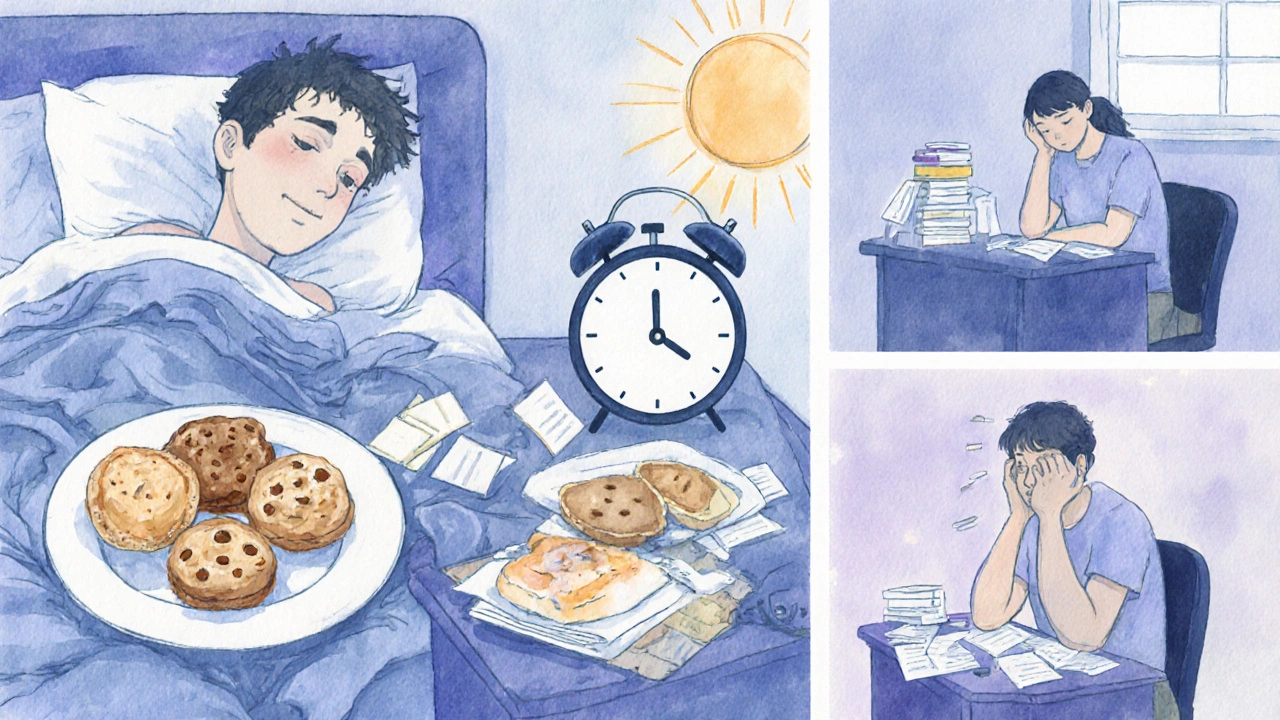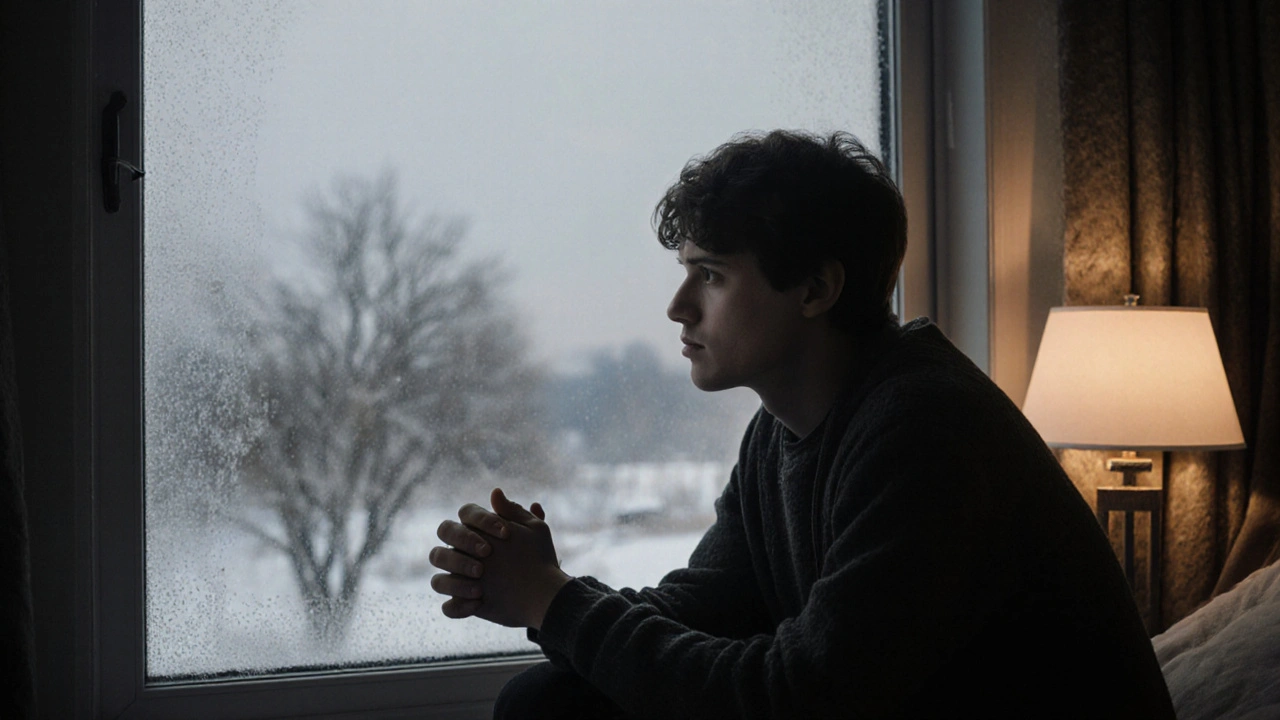Seasonal Affective Disorder (SAD) Self-Assessment Tool
Instructions
Answer "Yes" to at least four items below. If symptoms recur annually, SAD is a possibility. Click on each item to toggle your response.
Symptom Checklist
Your Assessment Results
When the days grow shorter and the sky looks gray, many people notice a dip in mood, energy, or motivation. That shift can be more than a temporary slump - it might be Seasonal Affective Disorder, a recurring mood condition that strikes during the colder months. Below you’ll learn how to spot the warning signs, why it happens, and what practical steps you can take to feel better again.
Key Takeaways
- Seasonal Affective Disorder usually appears in autumn or winter and fades in spring.
- Common symptoms include low energy, increased sleep, craving carbs, and feeling down.
- Root causes involve reduced sunlight, melatonin spikes, serotonin dips, and vitamin D deficiency.
- Effective treatments range from light therapy boxes to CBT, vitamin D supplements, and lifestyle tweaks.
- If symptoms interfere with work, relationships, or safety, see a mental‑health professional.
What Is Seasonal Affective Disorder?
Seasonal Affective Disorder is a mood disorder that follows a seasonal pattern, most often emerging in the fall and winter months. It is classified under the broader category of depressive disorders and affects roughly 5% of the U.S. population, with higher rates in northern latitudes.
Common Symptoms and How to Spot Them
Symptoms can vary, but most people notice a cluster of physical and emotional changes that develop gradually as daylight wanes. Typical signs include:
- Persistent low mood or feelings of melancholy.
- Loss of interest in hobbies or social activities.
- Reduced energy and increased fatigue.
- Oversleeping (often more than 9hours per night) or difficulty waking up.
- Heavy cravings for carbohydrates, leading to weight gain.
- Difficulty concentrating at work or school.
- Social withdrawal and reduced motivation to exercise.
If these symptoms appear each year around the same time and improve in spring, SAD is a likely explanation.

Why It Happens: The Science Behind SAD
Researchers have identified several biological mechanisms that trigger the seasonal swing.
Melatonin is a hormone that regulates sleep‑wake cycles. Short daylight periods stimulate excess melatonin production, which can make you feel sleepy and low‑energy.
Serotonin is a neurotransmitter linked to mood. Reduced sunlight diminishes serotonin activity, contributing to depressive feelings.
Vitamin D is synthesized in the skin when exposed to UV‑B rays. In winter, many people become deficient, and low vitamin D levels correlate with mood disturbances.
Circadian Rhythm disruptions occur when the internal clock receives fewer daylight cues. This misalignment can affect hormone balance, appetite, and mood.
Self‑Assessment Checklist
Use the following quick checklist to gauge whether you might be experiencing SAD. Answer “yes” to at least four items, and note if symptoms recur each year.
- Do you feel unusually sad, irritable, or hopeless during fall/winter?
- Do you sleep longer than usual or have trouble getting out of bed?
- Do you crave sugary or starchy food more than at other times of year?
- Has your energy level dropped dramatically compared with summer months?
- Do you have difficulty concentrating at work or school?
- Does your mood improve noticeably once spring arrives?
Treatment Options: What Works Best?
Several evidence‑based approaches help lift mood and restore daily function. The following table compares the most common options.
| Method | Typical Effectiveness | Usual Duration | Pros | Cons |
|---|---|---|---|---|
| Light Therapy | ≈70‑80% | 20‑30minutes daily for 2‑4weeks | Non‑pharmacologic, rapid symptom relief | Initial cost of box, need consistent use |
| Antidepressants | ≈60‑70% | 4‑6weeks to notice effect | Well‑studied, useful for severe cases | Potential side‑effects, requires prescription |
| Vitamin D Supplement | ≈30‑50% | 2‑3months to raise blood levels | Low cost, easy to add to routine | Effect varies; must test blood levels |
| Cognitive Behavioral Therapy (CBT) | ≈55‑65% | 8‑12weekly sessions | Teaches lasting coping skills | Time commitment, may need insurance coverage |
| Lifestyle Adjustments (exercise, diet, sleep hygiene) | ≈40‑55% | Ongoing | No medication, improves overall health | Requires consistent habit change |
Light Therapy
Light boxes emit 10,000 lux of cool‑white light, mimicking sunrise. Sit about 12‑18 inches from the device each morning. Clinical studies show a 70‑80% response rate, especially when used within the first hour after waking.
Antidepressants
Selective serotonin reuptake inhibitors (SSRIs) such as sertraline or fluoxetine are commonly prescribed. They help normalize serotonin levels, which often dip in low‑light conditions. Always discuss dosage and side‑effects with a Psychiatrist or primary‑care doctor.
Vitamin D Supplementation
Testing blood 25‑hydroxy‑vitamin D can reveal deficiencies. Typical supplementation ranges from 1,000-2,000IU daily during winter, but dosage should follow lab results and medical advice.
Cognitive Behavioral Therapy (CBT)
CBT targets negative thought patterns that worsen depressive moods. A therapist guides you through exercises, mood‑tracking, and behavioral activation. Research indicates CBT can reduce SAD severity by up to 65% when combined with light therapy.
Practical Lifestyle Tweaks
Simple daily habits can supplement formal treatment:
- Get outside for at least 30minutes a day, even on cloudy days.
- Exercise regularly - brisk walking, jogging, or indoor yoga increases endorphins.
- Limit caffeine and alcohol in the evenings to improve sleep quality.
- Eat balanced meals rich in omega‑3 fatty acids, whole grains, and lean protein to stabilize blood sugar.
- Maintain a regular sleep schedule; aim for 7‑9hours and keep bedrooms dark at night.

When to Seek Professional Help
If you notice any of the following, it’s time to consult a mental‑health professional:
- Symptoms persist for more than two weeks and interfere with work or school.
- Thoughts of self‑harm or hopelessness appear.
- Physical health declines sharply (e.g., significant weight loss or chronic fatigue).
- Previous attempts at self‑care (light exposure, exercise) haven’t helped.
A qualified Psychiatrist or Primary Care Physician can evaluate severity, suggest medication if needed, and refer you to counseling services.
Frequently Asked Questions
Frequently Asked Questions
How long does light therapy take to work?
Most people notice an improvement within 3‑7days of daily sessions, though full benefits often appear after 2‑3weeks.
Can I use a regular lamp instead of a light box?
A regular lamp usually emits far fewer lux (under 500) and lacks the specific spectrum needed to affect melatonin. For reliable results, a certified 10,000‑lux light therapy box is recommended.
Is vitamin D alone enough to cure SAD?
Vitamin D can improve mood in people who are deficient, but it typically works best alongside light exposure or psychotherapy. It’s not a standalone cure for most cases.
Can SAD affect children?
Yes. Children and teenagers can experience seasonal mood drops, often showing irritability, sleep changes, and academic decline. Early detection and light therapy are especially effective in younger patients.
Do I need a prescription for antidepressants for SAD?
In most countries, antidepressants are prescription‑only. A doctor will assess severity, discuss side‑effects, and determine if medication is appropriate alongside other treatments.




aarsha jayan
October 10, 2025 AT 16:36Thanks for this thorough rundown! The checklist is a handy quick‑screen, and I love how the article breaks down the science in bite‑size chunks. Light therapy and vitamin D are often the first steps I recommend to friends, but the lifestyle tweaks you listed are gold too. Keeping a consistent sleep schedule can make a huge difference when the days grow short.
Rita Joseph
October 11, 2025 AT 14:50This guide hits all the right notes. I especially appreciate the clear table comparing treatment effectiveness; it makes it easier to discuss options with a clinician. The emphasis on seeking help if symptoms linger past two weeks is spot‑on. Great job summarizing a complex topic!
abhi sharma
October 12, 2025 AT 13:03Great, another light box for my desk.
Liam Davis
October 13, 2025 AT 11:16Really useful info! 😊 The distinction between melatonin’s role and serotonin’s drop really clarifies why we feel sluggish. Light therapy’s quick onset (3‑7 days for many) is encouraging, and the dosage tips are practical. If anyone’s considering supplements, checking blood levels first is wise. Keep the science coming! 🙏
Arlene January
October 14, 2025 AT 09:30Yo, this post is fire! 🔥 You nailed the why‑and‑how of SAD. The vibe of mixing light boxes with daily walks is exactly what I tell my gym crew. And those veggie‑rich meals? Solid for boosting mood. Let’s keep crushing those winter blues together!
Kaitlyn Duran
October 15, 2025 AT 07:43Interesting how vitamin D deficiency ties into mood swings. I’ve seen friends feel more energetic after a simple supplement regimen. It’s great that the article stresses testing before dosing.
Terri DeLuca-MacMahon
October 16, 2025 AT 05:56💡💪 Loving the positivity here! Light therapy, fresh air, and a dash of movement-exact recipe to beat the winter slump. 🌞🚶♀️ Don’t forget a splash of humor; laughing boosts serotonin too! 🎉 Keep shining, folks!
Mia Michaelsen
October 17, 2025 AT 04:10From a clinical perspective, the comparative table is spot‑on. Evidence shows light therapy yields a 70‑80% response rate, making it first‑line for mild‑moderate SAD. Antidepressants remain valuable for severe presentations, especially when comorbidities exist. Vitamin D supplementation, while modestly effective, should be adjunctive after confirming deficiency.
Kat Mudd
October 18, 2025 AT 02:23First off, kudos for pulling together such an exhaustive overview-there’s nothing like a well‑structured, data‑driven guide to cut through the fog of seasonal gloom. The introductory section does a solid job contextualizing SAD, reminding readers that it’s not just a "winter blues" but a diagnosable mood disorder affecting a sizable slice of the population, especially in higher latitudes. The checklist is an excellent self‑screening tool; I appreciate the clear threshold of four positive responses as a pragmatic cutoff. Moving into the pathophysiology, the article wisely delineates the interplay between melatonin surge, serotonin dip, and vitamin D scarcity, which collectively disrupt circadian homeostasis and neurochemical balance. By explaining how reduced daylight drives melatonin overproduction, you give readers a mechanistic anchor for why they feel lethargic and despondent during shorter days. Similarly, the link to serotonin-our brain’s happiness molecule-highlights the biochemical rationale behind mood swings. The vitamin D segment is also crucial; many overlook this micronutrient’s role in brain health, yet its deficiency correlates strongly with depressive symptoms. The treatment matrix is perhaps the most valuable component; the side‑by‑side comparison of light therapy, antidepressants, supplementation, CBT, and lifestyle tweaks empowers readers to weigh efficacy, duration, pros, and cons in a digestible format. I’d add a note about the potential for combined approaches-e.g., light therapy paired with CBT can yield synergistic benefits, a fact supported by several randomized trials. The detailed guide on light therapy usage-duration, timing, and lux intensity-is spot‑on; many novices stumble on the practicalities, such as positioning the box at the appropriate distance and maintaining a consistent schedule. The discussion of antidepressants wisely cautions about side effects and the necessity of medical supervision-important for anyone considering pharmacotherapy. Vitamin D dosing guidance, while modest in effect, is a low‑risk adjunct that should indeed be tailored to serum levels; I’d suggest routine testing before embarking on high‑dose regimens. The CBT overview is succinct yet informative, emphasizing thought restructuring and behavioral activation, both of which have proven efficacy in seasonal depression. Lifestyle recommendations-daily outdoor exposure, exercise, dietary balance, and sleep hygiene-reinforce the holistic nature of SAD management and are likely to resonate with readers looking for non‑pharmacologic options. The section on when to seek professional help is clear and compassionate, flagging red‑flag symptoms like persistent hopelessness, self‑harm ideation, or significant functional decline. Lastly, the FAQ addresses common misconceptions, particularly about the adequacy of regular lamps versus therapeutic light boxes, and clarifies that vitamin D alone isn’t a panacea. Overall, the article strikes an effective balance between scientific rigor and accessibility, making complex neurobiological concepts understandable to a lay audience while providing actionable steps. It’s a model piece for health communication-well‑structured, evidence‑backed, and empathetically written. I would only suggest a brief mention of potential contraindications for light therapy, such as bipolar disorder, where it might precipitate mania, to further safeguard readers.
Pradeep kumar
October 19, 2025 AT 00:36Appreciate the comprehensive coverage-especially the integration of circadian rhythm jargon which adds depth without alienating newcomers. The synergy between light exposure and neurochemical modulation is well‑articulated, and the recommendation to pair phototherapy with behavioral activation aligns with best‑practice protocol.
Monika Kosa
October 19, 2025 AT 22:50Honestly, I think there’s more to the story-have you considered the hidden agenda of big pharma pushing meds for a seasonal mood dip? Just saying, stay skeptical about quick fixes.
Gail Hooks
October 20, 2025 AT 21:03🌍💭 The cultural lens is fascinating-some societies embrace winter light festivals that naturally combat SAD symptoms. It reminds us that community rituals can be as therapeutic as any box of photons.
Barry White Jr
October 21, 2025 AT 19:16Light boxes work good they help a lot
Andrea Rivarola
October 22, 2025 AT 17:30From a grammatical standpoint, the article maintains a consistent tense throughout, which aids readability, and the occasional use of semicolons appropriately separates complex clauses, reinforcing the nuanced nature of the subject matter. Moreover, the balanced sentence length prevents monotony while ensuring the flow remains engaging for readers of varying expertise levels.
Tristan Francis
October 23, 2025 AT 15:43The info is solid but remember big tech monitors light exposure too
Keelan Walker
October 24, 2025 AT 13:56Honestly this piece is super thorough and I love how it breaks down the science behind Seasonal Affective Disorder into bite sized pieces that anyone can understand it also gives practical steps like using a light box which is effective for most people and adds that vitamin D supplement can really help when you’re low it’s not just about the light but also about getting outside even if it’s cloudy because natural light still makes a big difference and exercise is a huge mood booster the article even mentions CBT as a therapy that can rewire negative thought patterns and that’s powerful the recommendations are realistic and not too overwhelming making it easier for people to actually follow through and the reminder to seek professional help if symptoms linger past two weeks is crucial it protects people from ignoring serious issues and the FAQ clears up common myths like regular lamps not being enough and the fact that vitamin D alone isn’t a cure for everyone overall the guide feels balanced supportive and backed by solid evidence it’s exactly the kind of resource people need during the darker months